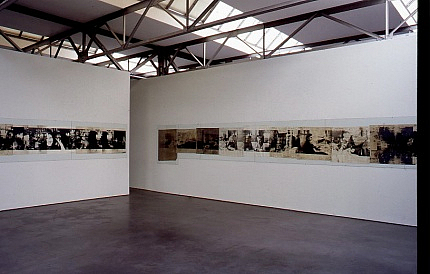Early in 1996, De Pont purchased a four-part work by the German painter Sigmar Polke (Oels, 1941). This acquisition, Hermes Trismegistus 1-4 (1995) was first shown at the 1995 Carnegie International in Pittsburgh. After having been on view in Tilburg for the past year, the work will now, in the coming year, be part of a large exhibition of Polke's work that is to be held first in Bonn and then in Berlin. The paintings will be on loan until April of 1998.
In consultation with the artist, a significant replacement for this important work was sought. As of June, the photographic work Hamburg Lerchenfeld (1975-1976) will be shown in the Polke space. This temporary loan gives us the opportunity to explain Polke's unusual way of dealing with the medium of photography. The series of photographs that he produced throughout the course of his career constitutes an independent and prominent part of his oeuvre. Due to his experimentation with the countless ways in which to employ the photographic image (solarization, montage, `painting over' the image, collage, to name only a few of these), the works display, like many of his paintings, a whimsical transformation of images, material, form and intention.
Hamburg Lerchenfeld consists of many photographs, printed onto inexpensive paper, which form a frieze of about thirty meters in length. The photographs vary in height, and the images seem to shift through and in front of each other. Furthermore, much of what goes on is partially concealed from the eye by messy spots and areas that have become dense or hazy. Together with Bowery New York (1973) and Sao Paulo (1975), the work is part of the group of photographic works in which Polke portrayed the fringes of society and the struggle of ghetto life - the homeless in New York, the transvestites and homosexuals in sweltering Brazilian bars, scenes from the pubs of Hamburg's Lerchenfeld.
Polke's way of photographing is fast and concentrated; but most of all it simply registers. It seems as though the presence of his camera has basically not influenced the people. At times there is even a display of carefree participation, as the artist incorporates images of himself, laughing or filming. These series have the quality of an eye-witness report but are stripped of any pathos. And despite the cruel social reality, they are imbued with a belief in beauty which lifts each of the images out of the maelstrom of incidents.
The series ultimately took shape through the arrangement and the extensive manipulation of the images. In addition to his own improvisations, every conceivable technique was used by Polke to manipulate the photographic images and even the chemical reactions that occur in the developing process. The traces of emulsions form fanciful patterns that erode the depictions and make parts of them unrecognizable. Due to the rampant growth of these elements, there arises a unity among the images, and the serial aspect is emphasized: it is as though the same theme recurs in ever-changing perspectives. Polke moreover instills these works with an atmosphere like that of the world that he has photographed: one of sudden occurrences and possible confrontations, of fragmentation and neglect.
These works of Polke can, in fact, be linked with etchings by Goya (1746-1828) in which he criticized the poltical situation in his country at the end of the eighteenth century: the totalitarian methods of the Inquisition and the perversity of power - a world in which the spirit of the Enlightenment was scarcely evident. Polke was particularly interested in the dark backgrounds against which Goya set his scenes of war and torture. From those dark depths in Goya's works, there emerge nightmarish monsters which are sometimes only half visible. Here too, these forms and dark realms infest the images like traumatic dreams.
The unity that Polke brings about in the scenes seems to be a deliberate attempt to introduce a criticial perspective in the work, one which goes beyond his own `social involvement' as the maker of the work. Referring to the grid, which he has painted over the depictions of his paintings since the mid sixties (and which, as a unifying factor, can be compared to his photographic manipulations), Polke said the following in 1966: `To me, (it) is a system, a principle, a method, structure. It divides, distributes, orders and makes everything equal... I believe that, seen in this way, my use of the grid already yields a very specific point of view, renders in itself a general situation and interpretation: namely the structure of a social order, of a culture, established, arranged, divided, classified, grouped, specified.'
